ASPIRE ALMA (2022.1.01077.L)
ALMA-ASPIRE is a 100-hour large program to observe Band 6 mosaics in the fields of 25 z>6.5 quasars.
With a total observing area of 33 sq. arcmin made up of 25 1.1x1.2 arcmin mosaics, we are able to map out the Mpc-scale environments around quasars and blindly detect [C II] emitters at z>6 and submillimeter galaxies at high redshifts. Together with the already secured multi-wavelength observations, we will investigate the black hole fueling mechanisms at multiple scales and phases, ascertain whether quasar environment is dusty, and understand how the strong quasar radiation affects the formation of galaxies at different masses. Here we highlight some of our main science goals.
Unveiling the Mpc-Scale Environments of Quasars in the millimeter wave

To date, most z>6 quasars with ALMA imaging are single pointings, so we cannot constrain their dusty environments beyond a few hundred kiloparsecs. If quasars are signposts of protoclusters or overdense environments, this signal is better probed on the scale of a few Megaparsec according to theoretical predictions. This is the first large program yielding the millimeter perspective of the dust-obscured star-forming galaxies in the quasar's extended neighborhood; many of these dusty galaxies are undetectable with current HST observations. Will we uncover filaments of physically associated galaxies, or do quasars live in unremarkable regions of the cosmic web? Whether quasar environment is dusty, and how the strong quasar radiation affects the formation of galaxies at different masses?
Measuring blank-sky millimeter number counts

The current best 1.2mm continuum source number counts comes from the ASPECS program which targets 35 sources. The major uncertainties are from cosmic variance (shaded region) and small number statistics, but by targeting many fields across a wide area, we expect to recover several hundred continuum sources to accurately constrain 1.2mm number counts.
Deep pencil beam surveys are of fundamental importance for studying the high-z universe, but inferences about galaxy population properties are in practice limited by cosmic variance. Since cosmic variance decreases with increasing survey area and the number of widely separated fields, we target 25 separate mosaic fields. These will provide the most accurate number counts measurements of 1.2mm continuum sources by identifying more than 200 galaxies, a tenfold increase upon previous blank field studies. More importantly, the accompanied multi-wavelength dataset will allow us to measure the redshifts of these continuum sources and enable the redshift distribution measurement of 1.2mm continuum sources to constrain the origin of the cosmic infrared background.
Measuring the [C II] galaxy luminosity function at z>6

The [C II] luminosity function are still largely unknown at z>6 (Uzgil et al. 2021). This program will enable a flux-limited survey of [C II] emitters at z>6. It will allow us to precisely determine the [C II] luminosity function at z>6 which is urgently needed to provide constraints to theoretical models.